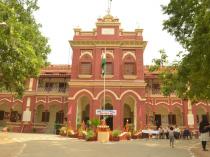I have got 113 marks in JEE Mains and 77% in boards. Can I get NIT, Patna with CS or mechanical?
I am from Bihar.
-

Answered by
AISHWARYA MUKHOPADHYAY student of civil engineering(b.tech) | Contributor-Level 8
9 years agocheck the college predictor.u may get some help.all the best! :) -
Well, I don't think that you can get admission in NIT-Patna within these marks.
-

Answered by
Sai Dhanavade I'm a engineering student. I love to write. | Contributor-Level 8
7 years agoHello Monu, with the help of Shiksha college predictor, you can see whether you can get admission in your favorite college. Here's the link for it-
https://www.shiksha.com/b-tech/resources/jee-mains-college-predictor
After predicting your college, you can collect information about that college.
Similar Questions for you
- Candidates with JEE Main percentile 20 and above are given first priority in the REAP merit list. Then, candidates with JEE Main percentile less than 20 are considered.
- Second priority will be given to the class 12 marks.
- Candidates with DVoc qualifications will be given third priority
Candidates with JEE Main scores of 20 percentile and above are given priority in REAP merit list. If you do not have JEE Main score, you will get less priority in ranking.
JMI JEE Main Cutoff 2025 has been released for admission to the BTech programme. The first round closing cutoff ranged from 17752 and 51961 for the General category candidates under the All India quota. The most sought-after BTech specialisation was B.Tech. in Computer Engineering with a cutoff rank of 17752, and the least popular was B.Tech. in Civil Engineering programme. For more details, click here.
The MSU Baroda JEE Main cutoff 2025 was released for admission to the BE/BTech programme for all rounds and categories under the All India quota. For the General AI category the cutoff ranged from 900036 to 932461 for admission to the BE course. The toughest specialisation according to the first round closing ranks was B.E. in Computer Science and Engineering, and the easiest BE specialisation was B.E. in Irrigation and Water Management, with the first round closing cutoff being 900036 and 990078.5, respectively. Students can click here to know more about JEE Main cutoff 2025.
Candidates who are participating in Uttarakhand BTech counselling through JEE Main score need to provide details about their application & roll number and All India Rank (AIR) of JEE Mains exam. The allotment of seats will be based on the rank of JEE Main.
Taking an Exam? Selecting a College?
Get authentic answers from experts, students and alumni that you won't find anywhere else
Sign Up on ShikshaOn Shiksha, get access to
- 66k Colleges
- 1.2k Exams
- 680k Reviews
- 1800k Answers



